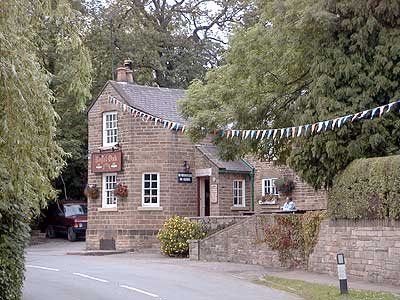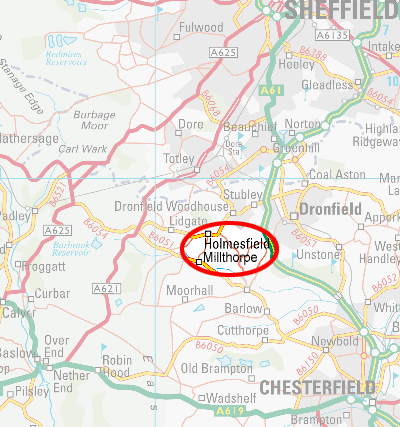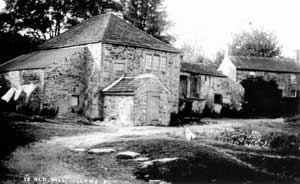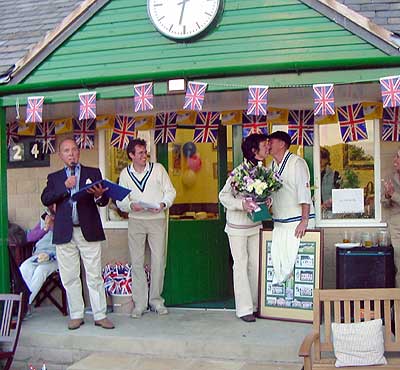|
|
|
Most of Millthorpe's residents who are not self employed or retired must now commute to nearby Dronfield, Chesterfield, or Sheffield for employment. |
 There is little in the way of amenities apart from the local pub - the Royal Oak (pictured right). Although it closed in late Summer 2004, it reopened before Christmas 2005, courtesy of a group of enterprising local people who wished to see it remain as an important focal point for the community. There is little in the way of amenities apart from the local pub - the Royal Oak (pictured right). Although it closed in late Summer 2004, it reopened before Christmas 2005, courtesy of a group of enterprising local people who wished to see it remain as an important focal point for the community.
It is hard to believe that less than 50 years ago, there was a thatched tea room and village shop - since demolished and rebuilt as the famous "Bobbys Cafe" which was to serve locals and the many keen walkers that descend on Millthorpe at weekends until a further rebuild saw the building become a holiday cottage and Coghlan's cookery and dining establishment. |
 |
There was another tea room and shop further down Cordwell Lane in the old school house, latterly run by the Chuttleborough family who hailed from Rotherham before that too closed and was turned into a private residence. (Picture courtesy of Pat Morton). |
|
The purchase of the ground by the club has meant that it was has been possible to enhance the facilities and a splendid new stone built pavilion now graces one of the most picturesque grounds in the Yorkshire & Derbyshire Cricket League. The provision of the new pavilion and practice nets must have had a profound effect on the players as the club won it's first Championship in its history in 2003 as Holmesfield CC fired its way to The Howden Trophy and promotion to the top division! The picture shows Rachel Pearson receiving a bouquet of flowers from husband Tom as an appreciation for her sterling efforts with supplying the teas throughout the season. The occasion was 2003's celebration of Tom's years of dedicated service to the club - both on and off the pitch. Committee members Stuart Huckerby and John Barber are also in attendance. Of course the most common leisure activity in Millthorpe is walking and there a several excellent walks to be enjoyed around the surrounding countryside. |
|
Through his involvement with such groups as the Progressive Association, the Fellowship of the New Life, the Fabians, and the Social Democratic Federation (SDF), he met important political and social theorists such as William Morris, Havelock Ellis, and Olive Schreiner, one of the leading socialist feminists of the time. In 1884, William Morris broke alliance with the SDF and formed the Socialist League, and Carpenter followed suit. Of his many writings the best remembered is probably his long poem of very free verses Towards Democracy (published in 4 parts, 1883 - 1902). In winter 1889-90, Carpenter met George Merrill, a working-man from the Sheffield slums on a train who was to become his lover for the next thirty years. In 1898 Merrill moved into Carpenter's cottage, against the advice of all of Carpenter's friends and remained with him until his death. Their living together brought them both happiness, and it is difficult now to conceive what a radically daring and courageous step it was in 1898. With Merrill, Carpenter kept open house for the immense number of friends in all ranks of life and from all countries who were attracted by his personal charm or his writings. At Millthorpe, friends and visitors such as George Bernard Shaw, Bertrand Russell, D H Lawrence, Cecil Reddie and others of the same mentality, gathered to discuss their ideas. Carpenter, one of the great figures of utopian socialism, crossed the divide between class, gender and monogamy. His mission was a form of simple living; he eschewed the city and embraced the elements. He threw open the windows and threw off his clothes in an effort to caste off the curse of respectability. He wanted to reunite people with the landscape. Carpenter believed it was easier to write well "bathed in sunlight". At Millthorpe he would bathe in the nude with Merrill at 6am in the summer before starting the day’s work. His emphasis on fresh air and sunshine was combined with running an orchard and market garden at Millthorpe. Sandal-making was another important activity. Sandals were a "symbol of the simple life" and "a liberation from the leather coffin". They were part of the movement for dress reform and also a significant part of the economy at Millthorpe. The trade in sandals received a mixed reception from the visitors. George Bernard Shaw obtained a pair, but upon wearing them for the first time, he cut his feet and vowed never to wear them again. His autobiography, My Days and Dreams, was published in 1916. In it, without of course being explicit, Carpenter treats his ménage with Merrill with considerable frankness. Many undestood perfectly what was implied in his idyllic portrait of the rural life of two bachelors. As time went on, Carpenter devoted more time to writing and less to marketing and gardening. He stayed at Millthorpe until 1922. Edward Carpenter died in Guildford on 28th June 1929. Several websites are devoted to Edward Carpenter, his life and his writings and some of these may be found on the links page. |
 The hamlet of Millthorpe lies on the very edge of the Peak District National Park and is situated in the picturesque Cordwell Valley of North East Derbyshire. It lies within the Parish of Holmesfield along with Holmesfield village and the hamlets of Owler Bar, Fanshaw Gate, Horsley Gate, Pewit, Lydgate, Cartledge, Cowley, Cowley Bar, Unthank and Bank Green.
The hamlet of Millthorpe lies on the very edge of the Peak District National Park and is situated in the picturesque Cordwell Valley of North East Derbyshire. It lies within the Parish of Holmesfield along with Holmesfield village and the hamlets of Owler Bar, Fanshaw Gate, Horsley Gate, Pewit, Lydgate, Cartledge, Cowley, Cowley Bar, Unthank and Bank Green. There has never been any industry of note in Millthorpe as it has always been an agricultural area. There was the Grist Mill near to the crash site of 1955 (pictured) but was demolished in the early 1970s - to the regret of many. Despite this, mine shafts were once in abundance around neighbouring Barlow, Dronfield, Dronfield Woodhouse and Unstone. Dronfield was famous for its steelworks, and Sheepbridge on the outskirts of Chesterfield was the site of a very large steel making complex.
There has never been any industry of note in Millthorpe as it has always been an agricultural area. There was the Grist Mill near to the crash site of 1955 (pictured) but was demolished in the early 1970s - to the regret of many. Despite this, mine shafts were once in abundance around neighbouring Barlow, Dronfield, Dronfield Woodhouse and Unstone. Dronfield was famous for its steelworks, and Sheepbridge on the outskirts of Chesterfield was the site of a very large steel making complex.  Sporting achievements have been courtesy of Holmesfield Cricket Club which has made Millthorpe its home since the 1950s and great strides have been made over recent years.
Sporting achievements have been courtesy of Holmesfield Cricket Club which has made Millthorpe its home since the 1950s and great strides have been made over recent years.  Despite its small size, Millthorpe's most famous former resident is Edward Carpenter (1844-1929) who was a noted reformer, poet, philosopher and gay rights pioneer and came from a large middle-class naval family. By 1868 he had established a career as a lecturer at Trinity Hall, Cambridge. In 1883, his father died and with his inherited wealth, Carpenter left Cambridge and purchased what is now known as Carpenter House in Millthorpe.
Despite its small size, Millthorpe's most famous former resident is Edward Carpenter (1844-1929) who was a noted reformer, poet, philosopher and gay rights pioneer and came from a large middle-class naval family. By 1868 he had established a career as a lecturer at Trinity Hall, Cambridge. In 1883, his father died and with his inherited wealth, Carpenter left Cambridge and purchased what is now known as Carpenter House in Millthorpe.